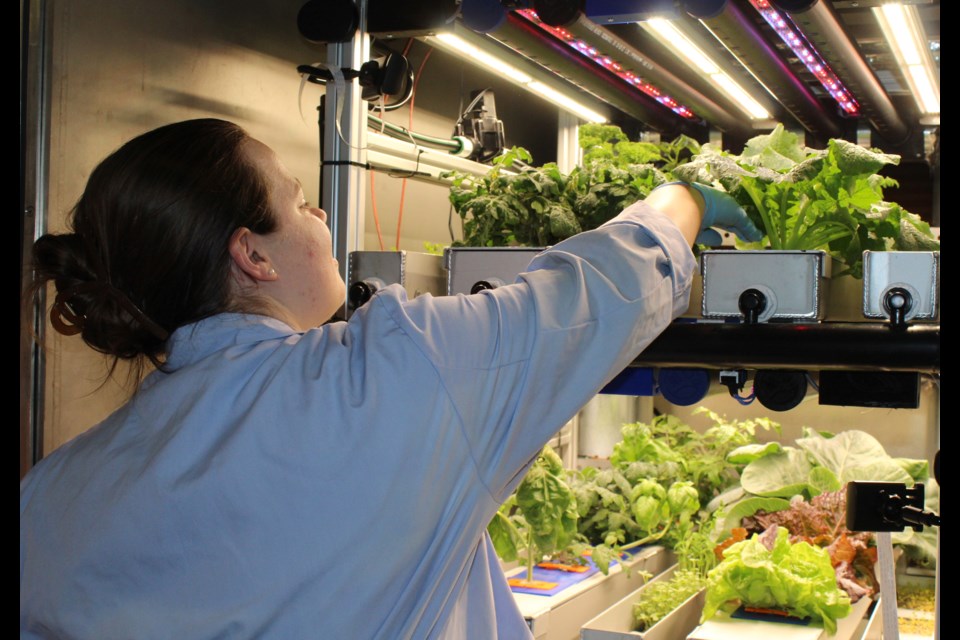The Canada GOOSE team at the University of Guelph can breathe a bit.
This, after working for months to bring a plant-growth chamber to life as part of the Deep Space Food Challenge.
Three panel members from the Canadian Space Agency (CSA) were able to take a gander at the chamber Thursday.
Canada GOOSE, or Growth Options for Outer Space Environments, is one of 10 Canadian entries who advanced to the second phase of the challenge, an international competition pitting teams against one another to develop food-producing technologies to use in harsh environments, such as outer space.
The much-anticipated moment in having the CSA in the same room as Canada GOOSE was both "nerve-wracking" and a "surreal experience," said team members.
"It was fun doing it as a group," said Rosemary Brockett, a second-year masters student.
"Having our other team members and knowing we're here and we spent months working towards this. It was really satisfying to make it here, and do all this together."
The Canada GOOSE prototype is a four-tiered vertical chamber.
The top three rows had many fruits and vegetable plants, such as turnips, carrots, dwarf tomatoes, peppers, leafy greens like cabbage, lettuce, basil and parsley, and microgreens.
"We do pea sprouts, radish microgreens and a nice zesty wasabi mustard. Those are just nine days to harvest," Brockett said.
The bottom row is the nursery, or plants in their infancy being supported by 3D printed holders and fabrics. There was also space alongside it for a bin to grow mushrooms.
Brockett said they tested out a lot of different fabrics, and had to determine how much water was needed in the troughs, and the amount of air flow needed.
"It was tricky to get it working for all the different types of plants," she said. "We spent about eight months testing different iterations of this to get here. There's still more refinement that can be done as well."
The chamber also has components outside, including cylinders to feed water and nutrients inside, as well as a special app to track progress of the plants.
The system itself, Brockett said, can be an important education tool. But there are still barriers in putting the chamber in isolated areas, such as having access to electricity, Internet, water and fertilizers.
While a bit tricky, she said it has potential to provide fresh food without having to rely on transportation, which is both costly and results in the food losing some of its nutrients and freshness.
On top of that, Serge Levesque, a second-year PhD student, brought up another factor: the rising cost of food in grocery stores.
"Canada's north, we have to make it secure for a lot of people," he said. "These types of systems will be important in the future."
Mike Dixon, director of the Controlled Environment Systems Research Facility at U of G, said he wouldn't propose this particular technology as an "economical solution to food production," but added the spin off technology has potential to create solutions.
"The prospect of food production systems in harsh environments, which is what we're all about – going to the moon or Mars – but that's the next worst environment after a snowbank in Canada," he said.
"Deploying this technology in harsh environments like Canada's north, and attempting to mitigate at least part of the food insecurity aspects of living in the far north (is an exciting prospect)."
Getting to this second phase, Canada GOOSE was given $30,000.
If they are one of the four to make the third phase, which will be decided in the next couple months, the team will be awarded $100,000 to scale up their prototype.
"The first priority (in the third phase) would be to build the outer shell," Brockett said. "Right now, we reused this massive chamber that we already had. So first, we would build the actual shell for this, which would be much smaller and more compact, and we would also work on refining some of the system."
The third phase will be about six months, which Dixon admits is tight and unrealistic.
But when telling that to the CSA panel, they seemed receptive to his comments.
Levesque added the team will need more help from engineering professionals, and plan to collaborate with different companies they've been in communication with.
There is much they have to work on, to conform to the rules put forth, including mass and amount of energy consumed.
But before all that, they have to make it to the third phase first. And all in all, the team likes their chances.
"It looked like we did very well," Dixon said. "I saw a lot of vigorous nodding of heads, so they understood the principles and the proof of concept that each of the elements of this project created."
